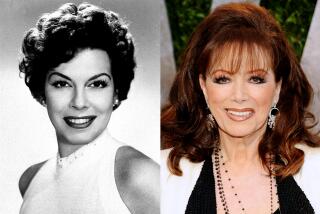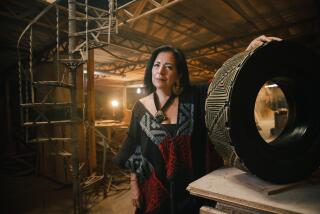Marisa Silver’s ‘Mary Coin’ imagines ‘Migrant Mother’s’ life
The starting point for Marisa Silver’s new novel, “Mary Coin,” was a moment of genius that unfolded on a California roadside more than 70 years ago.
Just outside the coastal valley town of Nipomo in 1936, photographer Dorothea Lange spotted a migrant farmworker family sitting in a tent off U.S. Highway 101. After a few minutes of conversation, Lange snapped six shots of a mother and her children. The sixth became the defining American photograph of the Great Depression.
Silver, a writer with a sharp eye for the visual (she began her artistic career as a filmmaker) saw that photograph in a 2009 exhibit at the Museum of Modern Art in New York. Known as “Migrant Mother” it shows two small children clinging to a woman in her 30s, her face fixed in a timeless expression of tenderness, poverty and fortitude.
“I’d seen the photograph before — it’s unbelievably magnetic,” said Silver, an L.A. resident, sitting at Stories, the Echo Park bookstore and cafe. But she was surprised by the curatorial description that accompanied the image. “It said that the woman in the photograph had never revealed who she was until she was sick and dying. That really just knocked me over.”
Only at the end of her life, nearly 50 years later, did Florence Owens Thompson, the subject of one the most famous pictures of the 20th century, step forward to say, “That’s me.” Silver wondered why.
“Was she embarrassed, ashamed, disenfranchised?” Silver asked. “There’s so many stories there I wanted to understand.”
Thus began a three-year process of research and artistic exploration that culminates this month with the publication of Silver’s fifth work of fiction. In “Mary Coin,” Lange and Thompson, the real-life historical figures, are reincarnated as fictional characters: photographer Vera Dare and her most famous subject, the migrant farm worker and mother of seven, Mary Coin.
The novel is a multi-generational saga that begins in 1920s Oklahoma and reaches into the first years of 21st century California. It’s an intimate epic inspired by two women whose paths crossed just once but whose real lives have been diminished in history by the power of that endlessly reproduced photograph.
“To me, the picture is an artifact,” Silver said. “I’m interested in history. How it is made, how it is told, and how it is interpreted. History is not objective, it’s a subjective thing.... We never really know what happened.”
Silver’s novels and fiction often treat themes of parenting and family relationships, and she dives deep into motherhood and child-rearing in “Mary Coin.”
The real-life Florence Owens Thompson remains an enigma. “There’s maybe 12 things publicly known about her,” Silver says. But the title character of “Mary Coin” comes alive as a deeply sensual and resourceful woman — who also happens to have seven children.
“One of the first things I knew about her as a character was that she was a sensual person,” Silver says. “I was working backward from the question, ‘Who is this woman who chooses to have this many children?’” Mary Coin loves her children, and she brought those children into the world because she was a woman unashamed of her own desires. “That’s a big part of who she is.”
In her novel, Silver evokes the eastern Oklahoma of Mary Coin’s youth with a series of imagined scenes built around the real-life landscape, towns and attitudes of the 1920s in that famously hardscrabble corner of America.
Mary grows up in a house built of sod that has walls alive with “worms and centipedes and colonies of ants,” making it possible for her “to imagine that her family lived underground, and that the house was nothing but a cave dug into dirt.” After Mary courts a good-but-frail young man and gets pregnant for the first time, she has a heart-rending honeymoon in her town’s only hotel.
Silver has grandparents from Oklahoma, but she wrote most of her novel in her Hollywood Hills home — during the hours her two teenage sons were in school. Her research included immersing herself in Great Depression memoirs, stories about families surviving and finding happiness in that time of need.
“They didn’t just starve, they also danced,” Silver said. “And they remembered the funny games their mothers played with them.”
Like Florence Owens Thompson, the fictional Mary is “not a victim,” Silver said. And yet when Mary and Vera Dare meet in Silver’s novel, Mary happens to be very near the end of her rope, as desperate and hungry as she’ll ever be.
In real life too, Lange encountered a woman who was destitute. The other five images Lange shot that day — she was working for a federal documentary project — are disturbingly bleak. Thompson’s four children are dressed in ragged clothes, their faces are soiled: Photographed from a distance, Thompson looks like she’s cowering inside her family’s crude tent.
For her final shot Lange pulled much closer and asked the children at Thompson’s side to turn — “Migrant Mother” was the result. Lange’s genius was to see and capture Thompson’s essential dignity even at her lowest moment. Silver is equally generous and insightful with the photographer and subject.
Silver’s experience in filmmaking helped her create the fictional photographer Dare. Her mother, Joan Micklin Silver, was part of a pioneering generation of female directors. And Silver herself has worked on documentaries and feature films.
It’s wrong to think that a camera can capture an “objective” truth, Silver said. Even the simple framing of an image is an act of interpretation. “You can’t take a photograph at face value,” Silver said. “You have to understand what happens around a photograph to understand what it really means.”
“Migrant Mother” captures a fraction of a second. “Mary Coin” unfolds over decades. Silver adds a mystery that takes the story to the Central Valley and eventually to the last days of the famous photographer and her equally famous subject.
“I wanted to see them at the end, because I wanted to know what their final reckoning was with this photograph that had defined their lives in such a huge way,” Silver said.
In “Mary Coin,” Silver takes a picture and spawns the proverbial thousand words many times over. The result is a stirring human portrait of two women and the times they lived in.
Silver will appear at ALOUD in conversation with poet and memoirist Meghan O’Rourke at 7:15 p.m. March 19 at the Los Angeles Public Library. More info: https://www.lfla.org/aloud
More to Read
Sign up for our Book Club newsletter
Get the latest news, events and more from the Los Angeles Times Book Club, and help us get L.A. reading and talking.
You may occasionally receive promotional content from the Los Angeles Times.










